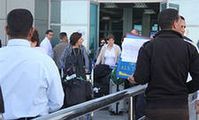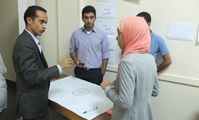Tourism

The Egyptian tourism industry is among the world's largest and most diverse. With revenues in 2006/2007 hitting US$ 8.2 billion, tourism is a key contributor to the country's GDP and a primary source of foreign exchange. In Egypt, tourism accounts for 3% of GDP, while the sector's total direct and indirect impact on the Egyptian economy is about 11.3% of GDP. A labor-intensive industry, tourism employs 2.3% of Egypt's non-agricultural workforce and generates employment and income in supporting industries including financial services, construction, security, handcrafts, food and beverages.
The target for Egypt is to consolidate its position as a key player in the global tourism scene by promoting the country as a cultural, entertainment, health and business destination. According to the World Tourism Organization, Egypt is currently among the top 25 destinations worldwide accounting for approximately 1% of the global market.
Tourists visiting Egypt currently account for 25% of all tourism coming into the Middle East and 33% of visitors to North Africa. Leisure tourism is the largest market segment, followed by business and conference tourism. Health tourism presents another viable area for Egypt, with Cairo assuming prime importance as one of the most important healthcare hubs of the region.
The government's national target is to increase Egypt's share of global tourism to 2.2%, boosting annual income from the sector to US $ 13.4 billion. Meanwhile, operators are ramping up to grow hotel capacity to 300,000 rooms — enough to serve the goal of hosting 18 million visitors by 2015, up from 9.6 million in 2007. These targets will generate some 1.2 million new job opportunities in the sector by 2015.
Today, Russian tourists account for the largest share of tourist arrivals from a single country to Egypt at 12% of total arrivals during FY 2006/07. While Europe remains the largest market for tourist arrivals to Egypt, increasing numbers of tourist are coming from the Arab region.
These visitors are presently served by 183,000 hotel rooms. More than 130.000 rooms are currently under construction and 665 new hotels are in the pipeline. In 2005, average room occupancy stood at 68.5%, with average room rates reaching US$ 57 per room night.
In 2007, some notable additions were made to the luxury hotel market, with the opening of the Four Seasons Hotel Alexandria (the brand's fourth property in Egypt) and the Sofitel EI-Gezirah Cairo (Sofitel's eleventh property in the country). In 2008, Egypt's first luxury Fairmont Hotel is also expected to start receiving visitors.
Recognizing that traditional tourism venues such as the Red Sea and UpperEgypt's antiquities are nearing saturation, the Egyptian Tourism Authority (ETA) is looking to develop alternative markets, including medical and 'golf tourism. In December 2007. Egypt hosted an international conference on health and therapeutic tourism, highlighting the importance of this sector to the industry.
Airports
Egypt's primary airports include Cairo International Airport, Borg El-Arab International Airport in Alexandria, Luxor Airport and Sharm El-Sheikh Airport. The country's national airline is EgyptAir, which flies to more than 84 destinations worldwide. All the major international carriers serve the Egyptian market, among them Air France, British Airways, KLM, Lufthansa and Swiss.
New airports in the resort areas of Mar-sa and Alamein on Egypt's North Coast have also become operational.
New Tourism Investments
More and more real estate developers from the Gulf are becoming interested in investing in Egypt's vibrant tourism sector. In July 2006, Emaar, the Dubai-based global real-estate giant, paid US$ 175 million at an auction for seafront resort land at Sidi Abdel Rahman on the Mediterranean coast. The highly coveted acquisition includes seven kilometers of pristine coastline that belonged to the state-owned Egyptian General Company for Tourism and Hotels.
Emaar is presently hard at work developing and marketing Marassi, its new year-round Mediterranean tourist destination in Sidi Abdel Rahman. The new resort will include several hotels, including a revamped version of the historic Sidi Abdel Rahman Hotel, as well as luxury villas, chalets, a marina and an 18-hole golf course. The project is expected to be complete in five years.
Following in the footsteps of Emaar, DAMAC — one of the Middle East's largest luxury property developers best known for its Dubai towers — made its debut on the Egyptian market. DAM-AC is currently developing a 320 million-square-meter tourism project in GamshaBay, 60 kilometers north of Hurghada.
The project, which is being billed as a "township," will be completed in phases over the course of 10 years.
The outlook for Egypt's tourism sector remains highly promising, with the year-on-year growth rate in tourist arrivals, easily surpassing the worldwide average.
Your Rating:
Overall rating: 0.000
Totally voted: 0
Comments
Weather in:
Exchange Rates
-
IMF loan expected next month
Apr 22, 2013, rating: 3.000, 3 votes Egypt may secure an International Monetary Fund loan agreement in about amonth, state news agency MENA reported, quoting "informed" sources ...
Egypt may secure an International Monetary Fund loan agreement in about amonth, state news agency MENA reported, quoting "informed" sources ...
-
Country's diesel reserve only enough for three days.
Feb 05, 2013, rating: 5.000, 1 votes Egypt’s strategic reserve of diesel fuel used for trucks and grouptransport vehicles can meet demand only for three days ...
Egypt’s strategic reserve of diesel fuel used for trucks and grouptransport vehicles can meet demand only for three days ...
-
Egypt received 11 million tourists in 2012 and aims to boost that number to 14 million in 2013.
Jan 22, 2013, rating: 3.000, 2 votes
Egypt received 11 million tourists in 2012 and aims to boost that number to 14 million in 2013.
-
Egypt limits travelers leaving country to US$10,000 in cash
Dec 26, 2012, rating: 3.250, 4 votes Egypt has banned travelers from carrying more than US$10,000 in foreigncurrency cash in or out of the country ...
Egypt has banned travelers from carrying more than US$10,000 in foreigncurrency cash in or out of the country ...
-
National Coalition on Climate Change for Egypt is born
Nov 30, 2012, rating: 5.000, 1 votes The global COP18 conference on climate change opens in Doha Monday.About 17,000 participants from all over the world ...
The global COP18 conference on climate change opens in Doha Monday.About 17,000 participants from all over the world ...
-
Egyptian family's average annual income is LE25,000, agency reports.
Nov 29, 2012, rating: 5.000, 1 votes The average annual Egyptian household income during 2010-2011 wasLE25,353, according to the Central Agency for Public Mobilization andStatistics.
The average annual Egyptian household income during 2010-2011 wasLE25,353, according to the Central Agency for Public Mobilization andStatistics.








